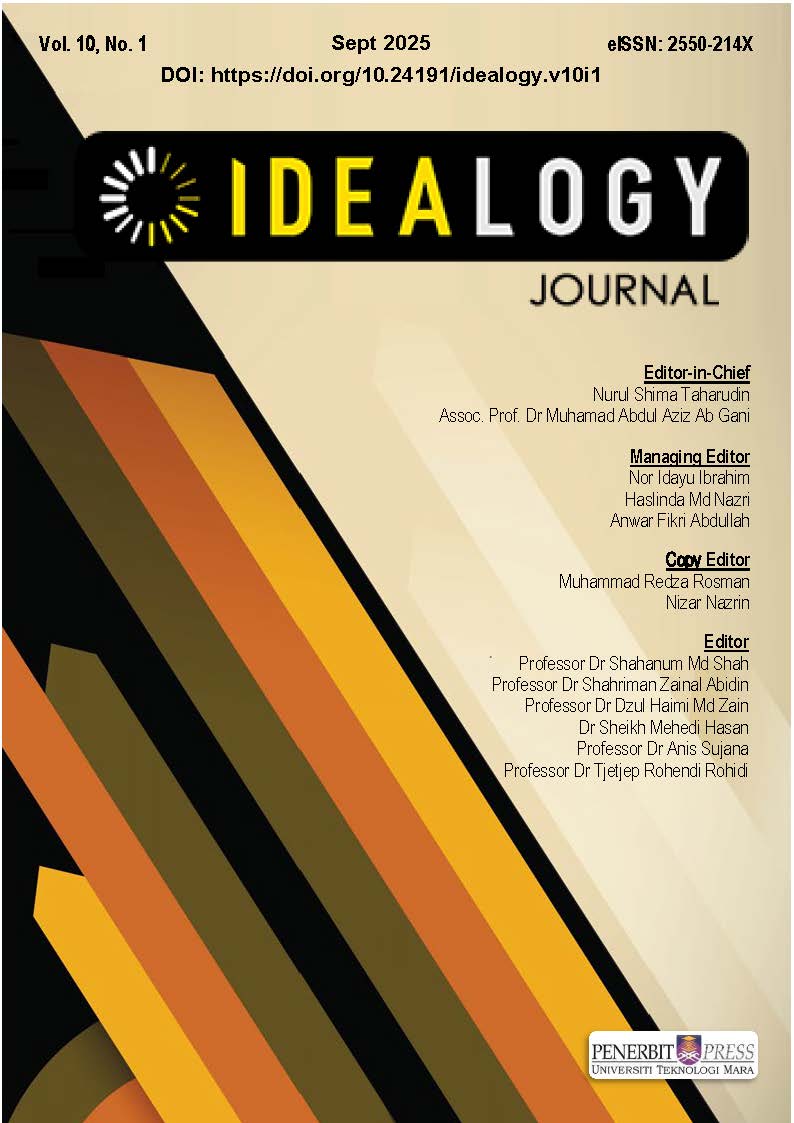Consumer and Business Perspective on Sustainable Packaging of Bubble Tea Industry in Malaysia
DOI:
https://doi.org/10.24191/idealogy.v10i1.770Keywords:
Sustainable Packaging, Bubble Tea Industry, Consumer Perspective, Business Perspective, Packaging WasteAbstract
The growing number of bubble tea shops in Malaysia has increased consumption, resulting in packaging waste issues. This research explores the perspectives of consumers and businesses on sustainable packaging in the industry. The research uses contextual document analysis to investigate the awareness of sustainable packaging among consumers and firms through scholarly articles in scholarly journals, online articles, blogs, and forum discussions. Previous studies suggest that consumers are increasingly interested in sustainable packaging, and businesses are becoming more environmentally conscious. However, challenges such as the cost of implementation and lack of infrastructure in some areas need to be considered. This study aims to analyse the understanding and awareness of sustainable packaging design among consumers and businesses in Malaysia. This research intends to shed light on the current state of sustainable packaging in the bubble tea industry and identify potential areas for improvement to address packaging waste issues.
Keywords: Sustainable Packaging, Bubble Tea Industry, Consumer Perspective, Business Perspective, Packaging Waste
References
Asim, Z., Shamsi, I. R. A., Wahaj, M., Ahmed, R., Hasan, S. A. A., Siddiqui, S. A., Aladresi, A., Sorooshian, S., & Teck, T. S. (2022). Significance of sustainable packaging: A case-study from a supply chain perspective. Journal of Cleaner Production, 250, 119-135. https://doi.org/10.1016/j.jclepro.2019.119135
Bakar, K. A., & Mohamed, A. F. (2024). Analysis of consumer preferences and attitudes towards sustainable consumption of plastic beverage packaging in Malaysia. IOP Conference Series. Earth and Environmental Science, 1304(1), 012003. https://doi.org/10.1088/1755-1315/1304/1/012003
Bowen, G. A. (2009). Document analysis as a qualitative research method. Qualitative Research Journal, 9(2), 27-40.
Braun, V., & Clarke, V. (2006). Using thematic analysis in psychology. Qualitative Research in Psychology, 3(2), 77–101. https://doi.org/10.1191/1478088706qp063oa
Braun, V., & Clarke, V. (2006). Using thematic analysis in psychology. Qualitative Research in Psychology, 3(2), 77-101.
Cheng, S. (2022). Development of eco-friendly bubble tea take-away cups. Journal of Environmental Management, 274, 111-125. https://doi.org/10.1016/j.jenvman.2020.111125
Creswell, J. W., & Poth, C. N. (2018). Qualitative inquiry and research design: Choosing among five approaches. Sage publications.
Gempak. (2024, April 22). Isu Straw Cepat Lembik, Akhirnya jenama minuman tempatan ini beri respons! Gempak. https://gempak.com/berita-terkini/isu-straw-cepat-lembik-akhirnya-jenama-minuman-tempatan-ini-beri-respons-87542
Global Business Accelerator. (2024). Impact of government policies and market trends on sustainable packaging practices in the bubble tea industry. Retrieved from https://www.globalbusinessaccelerator.com
Guest, G., MacQueen, K. M., & Namey, E. E. (2012). Applied thematic analysis. Sage.
Hamid, M. S. A., Rahman, N. A., Khalid, K. N., & Kassim, Z. A. (2022). Consumer awareness of sustainable packaging in Malaysia. Environmental Research and Public Health, 19(1), 12-24.
Kemper, A. (2024, June 7). Sustainability and Innovation in the paper Straws Market 2024 Meeting Environmental Demands and Regulatory Compliance. https://www.linkedin.com/pulse/sustainability-innovation-paper-straws-market-2024-meeting-kemper-w20sf/
Lee, C. J., Chang, L., & Tan, J. (2022). Environmental sustainability framework for plastic waste management—A case study of bubble tea industry in Malaysia. Sustainability, 14(10), 620-635.
May, O. S., Isa, M. a. B. M., & Ley, O. C. (2021). Determinants of customer satisfaction among youths who consume bubble tea (Tealive) in Selangor, Malaysia. Journal of Consumer Satisfaction, 35(2), 45-60.
Merriam, S. B., & Tisdell, E. J. (2016). Qualitative research: A guide to design and implementation. Jossey-Bass.
Nguyen, A. T., Parker, L., Brennan, L., & Lockrey, S. (2020). A consumer definition of eco-friendly packaging. Journal of Cleaner Production, 252, 119792. https://doi.org/10.1016/j.jclepro.2019.119792
Rajendran, S. D., Wahab, S. N., & Singh, M. K. P. (2019). Malaysian consumers’ preference for green packaging. Journal of Cleaner Production, 250, 119-135. https://doi.org/10.1016/j.jclepro.2019.119135
Research, C. (2023). Malaysian bubble tea market surge: Credence Research unveils a comprehensive analysis of growth, trends, and challenges through 2028. Retrieved from https://www.credenceresearch.com
Selena, C. (2019). 3 ways every Malaysian can reduce plastic waste when drinking bubble tea. SAYS. Retrieved from https://www.says.com
Suib, S. (2022). Packaging for delivery in Malaysia - Green Design Malaysia. Medium. Retrieved from https://www.medium.com
The Edge Malaysia. (2021). Sustainability solutions: Bringing environmentally friendly packaging into the mainstream. Retrieved from https://www.theedgemalaysia.com
Yeung, M. (2020). How bubble tea culture contributes to the plastic pollution crisis. Bobagreen. Retrieved from https://www.bobagreen.com
Downloads
Published
Issue
Section
License
Copyright (c) 2025 UiTM Press

This work is licensed under a Creative Commons Attribution-NonCommercial-NoDerivatives 4.0 International License.
UiTM Press (the Publisher) has agreed to publish the undersigned author’s paper in Idealogy Journal. The agreement is contingent upon the fulfilment of a number of requirements listed below.
1. The undersigned author warrants that the paper entitled below is original, that it is not in any way libellous or unlawful in Malaysia, that it does not infringe any copyright or other proprietary right. The undersigned hereby represents and warrants that he/she is the author of the paper, except for material that is clearly identified as to its original source, with permission notices from the copyright owners where required. The undersigned represents that he/she has the power and authority to sign and execute this agreement.
2. The undersigned author warrants that the paper entitled below has not been published elsewhere, and also it will not be submitted anywhere else for publication prior to acceptance/rejection by this Journal.
3. By submitting the paper entitled below, the undersigned author agrees to transfer the rights to publish and distribute the paper in an international e-journal (entitled above) to Publisher.
4. The undersigned author agrees to make a reasonable effort to conform to Publisher's submission guidelines and to liaise with the editor to ensure that the requirements of these guidelines are met to a reasonable degree.
5. The corresponding author signs for and accepts responsibility for releasing this material on behalf of any and all coauthors. This agreement is to be signed by at least one of the authors who has obtained the assent of the co-author(s) where applicable. After submission of this agreement signed by the corresponding author, changes of authorship or in the order of the authors listed will not be accepted.


